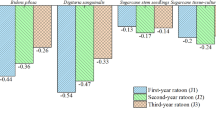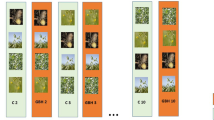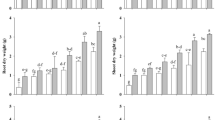Abstract
IT has recently been found in Malaya that the rubber tree, Hevea brasiliensis, when growing on certain soils, can accumulate sufficient boron to cause the appearance of boron toxicity symptoms on the leaves. The soils on which evidence of boron toxicity has been found are the recently deposited alluvial clay soils on the west coast of Malaya, on which approximately 20 per cent of the rubber in Malaya is grown, and certain coarse sandy loams derived in situ from a very acid granite where only a shallow layer of top soil overlies the decomposing parent material. The main leaf symptoms of boron toxicity on rubber, common to many plants, are the development of necrotic spots in the interveinal areas, particularly around the leaf margin, and of a tip and marginal necrosis which may take the form of a narrow regular band or may result in a large area of the leaf, at the distal end, becoming necrotic (Fig. 1).
This is a preview of subscription content, access via your institution
Access options
Subscribe to this journal
Receive 51 print issues and online access
$199.00 per year
only $3.90 per issue
Buy this article
- Purchase on Springer Link
- Instant access to full article PDF
Prices may be subject to local taxes which are calculated during checkout
Similar content being viewed by others
References
Kohl, H. C., and Oertli, J. J., Plant Physiol., 36, 420 (1961).
Owen, G., J. Rubber Res. Inst. Malaya, 14, 121 (1951).
Author information
Authors and Affiliations
Rights and permissions
About this article
Cite this article
SHORROCKS, V. Boron Toxicity in Hevea brasiliensis. Nature 204, 599–600 (1964). https://doi.org/10.1038/204599a0
Issue Date:
DOI: https://doi.org/10.1038/204599a0
Comments
By submitting a comment you agree to abide by our Terms and Community Guidelines. If you find something abusive or that does not comply with our terms or guidelines please flag it as inappropriate.



